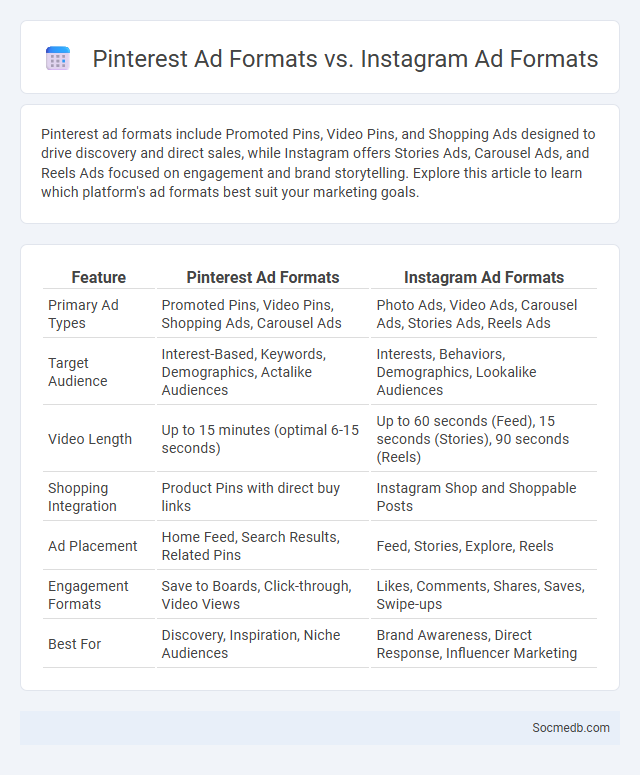
Photo illustration: Pinterest Ad Formats vs Instagram Ad Formats
Pinterest ad formats include Promoted Pins, Video Pins, and Shopping Ads designed to drive discovery and direct sales, while Instagram offers Stories Ads, Carousel Ads, and Reels Ads focused on engagement and brand storytelling. Explore this article to learn which platform's ad formats best suit your marketing goals.
Table of Comparison
| Feature | Pinterest Ad Formats | Instagram Ad Formats |
|---|---|---|
| Primary Ad Types | Promoted Pins, Video Pins, Shopping Ads, Carousel Ads | Photo Ads, Video Ads, Carousel Ads, Stories Ads, Reels Ads |
| Target Audience | Interest-Based, Keywords, Demographics, Actalike Audiences | Interests, Behaviors, Demographics, Lookalike Audiences |
| Video Length | Up to 15 minutes (optimal 6-15 seconds) | Up to 60 seconds (Feed), 15 seconds (Stories), 90 seconds (Reels) |
| Shopping Integration | Product Pins with direct buy links | Instagram Shop and Shoppable Posts |
| Ad Placement | Home Feed, Search Results, Related Pins | Feed, Stories, Explore, Reels |
| Engagement Formats | Save to Boards, Click-through, Video Views | Likes, Comments, Shares, Saves, Swipe-ups |
| Best For | Discovery, Inspiration, Niche Audiences | Brand Awareness, Direct Response, Influencer Marketing |
Overview of Pinterest, Instagram, and Paid Promotion
Pinterest and Instagram dominate visual social media, with Pinterest excelling in discovery and inspiration through curated boards and pins, while Instagram thrives on real-time engagement via stories, reels, and influencer content. Paid promotion on both platforms offers targeted advertising options leveraging detailed user demographics, interests, and behavior to maximize reach and conversion rates. Your brand can effectively harness Pinterest's intent-driven audience and Instagram's dynamic interaction to drive traffic and boost sales.
Types of Pinterest Ad Formats
Pinterest offers a variety of ad formats designed to engage users visually and drive conversions, including Promoted Pins, which blend seamlessly with organic content to enhance visibility. Video Pins capture attention through motion and sound, promoting brand stories and product features effectively. Shopping Ads integrate product details and pricing directly within pins, supporting direct purchase actions and boosting e-commerce performance.
Types of Instagram Ad Formats
Instagram offers diverse ad formats including photo ads, video ads, carousel ads, and Stories ads to engage audiences effectively. Photo ads feature a single image to highlight products or services, while video ads allow up to 60 seconds of dynamic content to capture attention. Carousel ads enable multiple images or videos in one ad, encouraging interaction, and Stories ads provide immersive, full-screen vertical content for temporary promotions and direct engagement.
Understanding General Paid Promotion
Social media paid promotions enhance your content visibility by targeting specific demographics, interests, and behaviors, ensuring higher engagement and conversion rates. Platforms like Facebook, Instagram, and LinkedIn offer advanced advertising tools that optimize budget allocation and performance tracking. Understanding these strategies allows you to maximize return on investment and effectively reach your audience.
Visual Differences in Ad Formats
Social media platforms each offer distinct ad formats optimized for user engagement, such as Instagram's immersive Stories ads featuring vertical full-screen visuals, and Facebook's versatile carousel ads allowing multiple images or videos in a single placement. LinkedIn prioritizes professional-themed ads with clean, minimal visuals to maintain a corporate atmosphere, while TikTok's short-form video ads emphasize dynamic, authentic content tailored to younger audiences. Understanding these visual differences helps advertisers tailor creatives to platform-specific user behaviors and maximize campaign effectiveness.
Targeting Capabilities Comparison
Facebook Ads offers advanced targeting options including demographics, interests, behaviors, and custom audiences, making it highly effective for precise audience segmentation. Instagram, leveraging Facebook's targeting algorithms, excels in reaching younger, visually-driven users with interest-based and lookalike audience targeting. Twitter's targeting capabilities emphasize keyword targeting and follower lookalikes, ideal for real-time engagement and niche audience outreach.
Engagement Metrics and Performance
Engagement metrics such as likes, comments, shares, and click-through rates provide critical insights into the effectiveness of your social media campaigns. Tracking these metrics helps you understand audience interaction and tailor content strategies to boost visibility and brand loyalty. Optimizing performance based on engagement data ensures your social media efforts drive meaningful connections and measurable growth.
Pricing and Budget Considerations
Social media pricing varies widely depending on platform, ad format, and targeting options, with costs typically measured by CPC (cost per click) or CPM (cost per thousand impressions). Allocating your budget efficiently requires analyzing audience demographics and campaign goals to maximize ROI within your set limits. You should also consider ongoing monitoring and adjustment costs to ensure optimal performance across multiple social media platforms.
Best Practices for Each Platform
Optimizing your social media strategy involves tailoring content to each platform's unique audience and features to maximize engagement. On Instagram, prioritize high-quality visuals and consistent posting times to enhance follower interaction, while Twitter demands concise, timely updates and active participation in trending conversations. LinkedIn thrives with professional insights and networking, making it essential to share industry-relevant articles and engage in meaningful discussions to expand your professional reach.
Choosing the Right Platform for Your Goals
Choosing the right social media platform depends on your target audience, content type, and marketing objectives. Facebook excels at building community engagement and offers robust advertising tools, while Instagram is ideal for visually-driven brands targeting younger demographics. LinkedIn provides a professional network for B2B marketing and industry thought leadership, making platform selection crucial for aligning with specific business goals.
 socmedb.com
socmedb.com